SEO vs PPC Advertising: Which One Is Better for Beginners?
You have built your website, now you need visitors. However, as a beginner, figuring out how to drive traffic can be confusing. That’s where the debate of SEO vs PPC comes in. Should you invest time in growing organic traffic through SEO, or pay for quick results with PPC ads? It’s a tricky choice.
Many small to medium businesses spend 7 times more on PPC than on SEO. Yet, 49% of marketers still believe SEO delivers the best ROI, helping you get steady traffic without spending a huge sum, compared to PPC.
Now, you may think that SEO will be the best if you have a low budget, or PPC will work best for you if you want faster results. Well, it’s not that simple.
To help you make a sound decision, we have created this blog. Here we’ll break down the key differences between SEO vs PPC, so you can choose the one that fits your goals and your budget.
What is SEO?
SEO, also known as Search Engine Optimization, is the process of improving your website to gain higher rankings in organic (non-paid) search engine results. In short, you make your content better so search engines like Google can understand it and show it to people whenever they are searching for any information.
How SEO Works?
SEO helps you get free and consistent traffic from search engines. You use relevant keywords related to your website, optimize content, and improve your website’s authority to rank higher in search results.
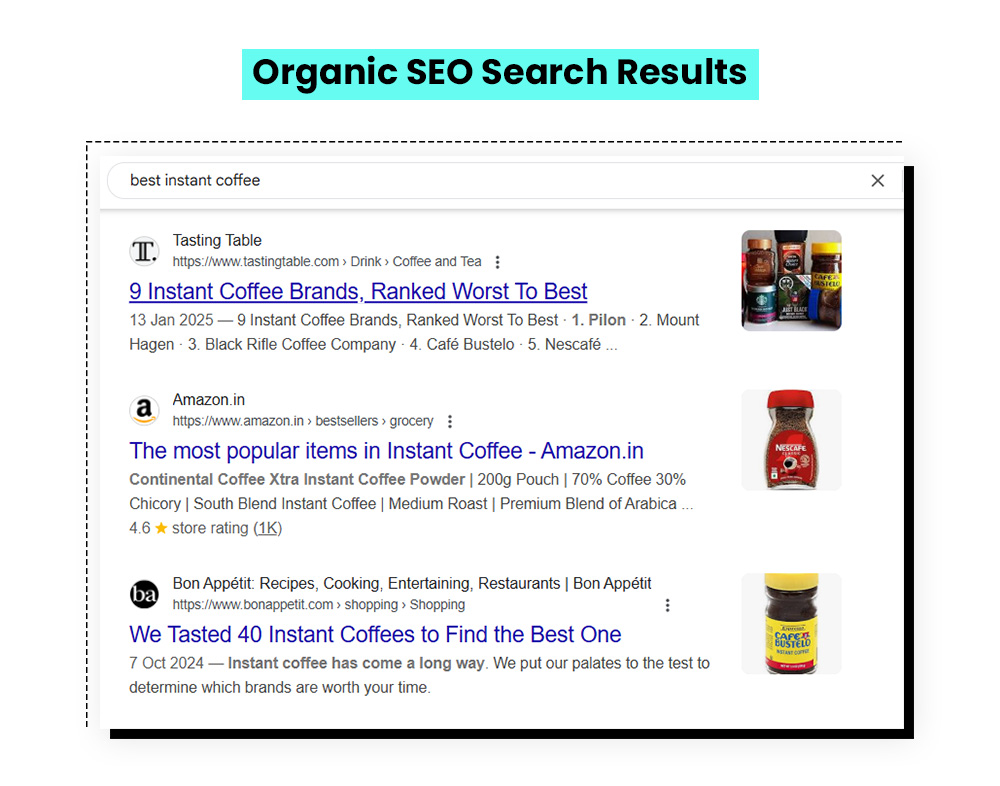
For example, if someone searches for “best instant coffee,” a blog post or a product page optimized with this keyword might appear in Google’s organic search results without you paying for the click.
Types of SEO
Now that you understand what SEO is and how it works, let’s explore the different types of SEO that help improve your website’s visibility.
1. On-Page SEO
This type of SEO is all about improving the content on your website pages so search engines (like Google) understand what your site is about.
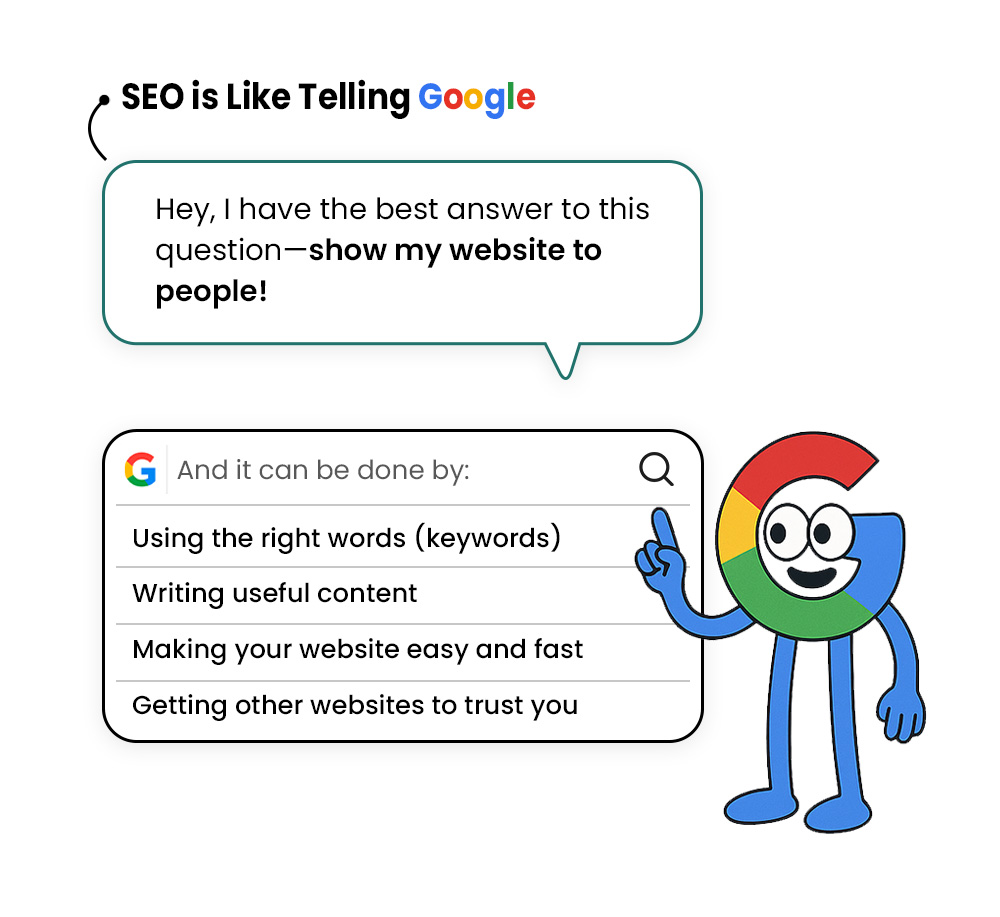
- Use the right keywords: Add your main keyword (like “SEO vs ppc advertising”) and related terms (like “organic traffic”) naturally in your titles, headings, and paragraphs. Also, interlink your blog post with other pages to improve site navigation and boost your SEO by distributing link equity across your website. This helps Google know what your content is about.
- Use structured headings: Break your content into sections using headings like H1, H2, and H3. This makes it easier for both users and search engines to read.
- Short, clear URLs: For example, use yourwebsite.com/seo-tips instead of yourwebsite.com/page?id=123.
- Create helpful content: Ensure your content answers people’s questions and provides real value. If someone searches “how to get more traffic,” your page should explain that clearly.
On-page SEO is all about what you do on your website (content, keywords, structure).
2. Off-Page SEO
This type of SEO is about building your website’s reputation and authority on the internet. It can be done by using high-quality backlinks. A backlink refers to when another website links to your site.
If a well-known blog in your niche links to your content, it develops confidence. Google sees this as a sign that your site is trustworthy and valuable. The more high-quality backlinks you have from trusted sites, the better your chances of ranking higher in search results.
3. Technical SEO
This focuses on making sure your website is easy for search engines to crawl and index.
-
- Fast loading speed: If your site loads slowly, people may leave quickly, and Google notices that.
- Mobile-friendly design: Your site should look good and work well on smartphones and tablets.
- Fix technical issues: Use tools like Google Search Console to find and fix errors, like broken links or pages that aren’t being indexed.
Don’t forget to read: The Ultimate Guide to Increasing Organic Traffic to a Website in 2025
Pros of SEO
SEO has many advantages that can help your website grow over time. Let’s look at them.
1. Cost-effective in the long run
Once your website ranks high in search results (like on the first page of Google), you don’t have to pay for each visitor. Unlike paid ads, which charge you every time someone clicks, SEO brings free traffic once your content is well-ranked.
2. Sustainable
If you create useful, high-quality content, it can keep bringing visitors to your site for months or even years. For example, a blog post about “how to do keyword research” might continue to get traffic long after it’s published.
3. Builds credibility and trust
People tend to trust organic (non-paid) results more than ads. In fact, 53.3% of people click on organic search results rather than paid ones (BrightEdge). So, ranking naturally helps your business look more trustworthy.
4. Higher click-through rates (CTR)
When users see your site in the top results (without the “Ad” label), they’re more likely to click on it. This means you get more traffic without spending on ads.
Cons of SEO
SEO can improve your website over time, but it also has some drawbacks that you should know before investing in it.
1. Takes time
SEO is not instant. It can take 3 to 6 months (or more) to start seeing results. Google needs time to understand your content and see how helpful it is compared to others.
2. Requires skill and effort
You can’t just publish anything and expect to rank. You need to follow all the SEO techniques (like proper headings and internal links) and continuously update and improve your content.
3. Highly competitive
Some keywords are popular. For example, ranking for “SEO vs PPC” is tough because lots of websites are already trying to rank for it. You’ll need time, effort, and a smart strategy to compete.
What is PPC Advertising?
Pay-Per-Click (PPC) advertising is a method of online marketing where you pay only when someone clicks on your ad. It’s a quick method to get targeted traffic to your website, which could be converted into leads.
Let’s say, if you’re a digital marketing agency, you might want to show your ad to people searching for “PPC advertising services or SEO vs PPC services.” You bid on that keyword, and if your ad shows up and someone clicks it, you pay for that click.
As you can see below, when you search for ‘best instant coffee,’ the website labeled ‘Sponsored‘ is a result of PPC advertising.
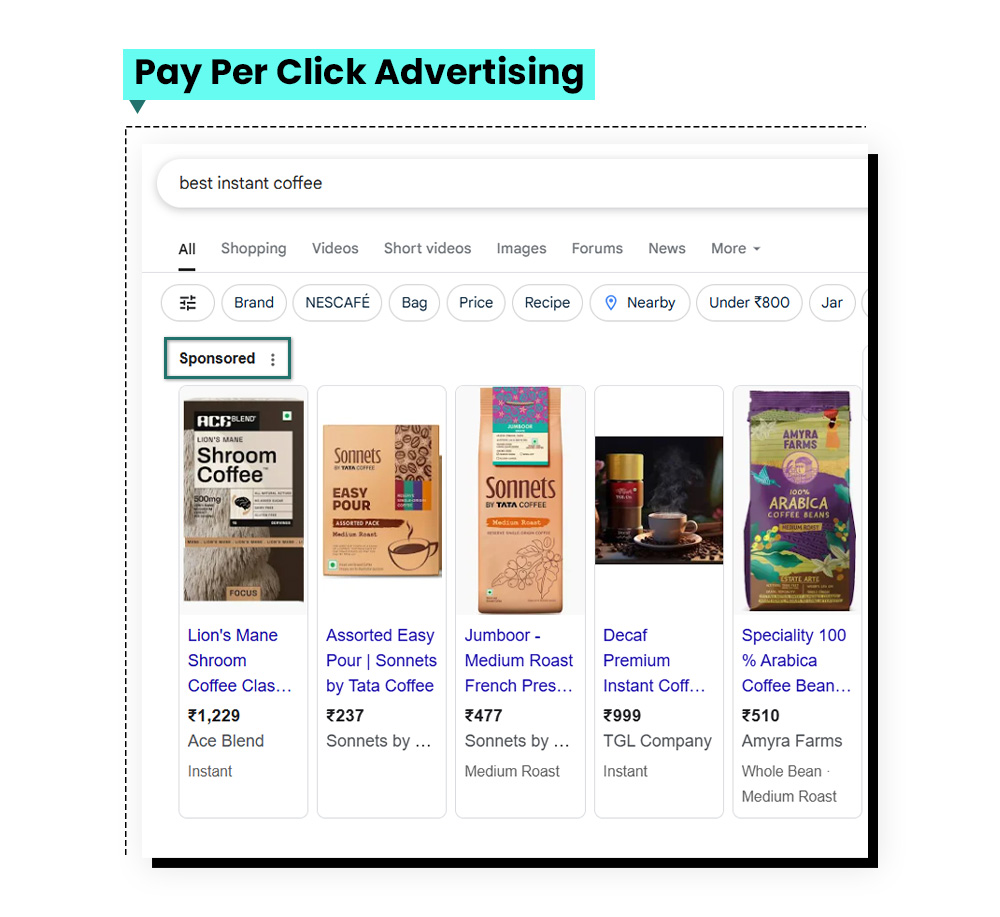
How Does PPC Work?
Let’s understand how PPC advertising works step by step using real examples:
Step 1: Choose a Platform
First, you choose where you want your ads to show. The most common platforms are:
- Google Ads: It’s for showing ads in Google search results or on websites.
- Facebook Ads: Showing ads to users on Facebook and Instagram.
- LinkedIn Ads: Great for targeting professionals by job title or industry.
Step 2: Pick Keywords or Target Audience
Next, you decide who should see your ads:
On Google, you choose keywords that people might search for. If you’re selling custom mugs, you might choose the keyword “personalized coffee mug.”
On Facebook or Instagram, you select your audience based on age, interests, location, etc. A fitness coach might target people aged 20–40 who are interested in fitness and health.
Step 3: Set a Budget and Bid
You can decide how much you are willing to spend. Set a daily or monthly budget (like $10 per day). Choose your maximum bid, the highest amount you’re willing to pay for one click. This controls your total spending and helps keep your campaign affordable.
Step 4: Create the Ad
You write a short, engaging ad with:
- A headline (like “Shop Personalized Mugs”)
- A short description (like “Great gifts starting at $12.99”)
- A link to your website
- Optional images or videos, especially on social media
Step 5: Your Ad is Shown
Once your ad is live, it will appear on Google when someone searches your chosen keyword.
For instance, when someone searches “personalized coffee mug,” your ad appears at the top of the search results.
On Facebook, it appears in the feed of people who match your selected audience. A fitness coach’s ad might appear in the feed of a 30-year-old who recently liked a fitness page.
Step 6: You Pay When Someone Clicks
You’re only charged when someone actually clicks your ad and visits your website. If no one clicks, you don’t pay. If someone clicks, you pay based on your bid and the competition for that keyword or audience.
The fitness coach might pay $0.50 for a click that leads to their training signup page. The mug seller might pay $1 for a product page visit.
A PPC agency can help manage your bids and target the right keywords so you get the most value for every click.
Click here to read: What is Paid Media, its Types and Benefits with Examples?
Types of PPC Campaigns
Once you understand how PPC works, it’s important to know the types of PPC campaigns you can run to reach your target audience effectively.
1. Search Ads
These ads always appear at the top of Google search results whenever you enter your query. It’s great for people who are actively looking for something (like “buy running shoes”).
2. Display Ads
These are image or banner ads shown on websites that are part of Google’s Display Network. These ads are good for brand awareness and reaching a wider audience.
3. Social Media Ads
These appear on platforms like Facebook, Instagram, LinkedIn, etc. You can target people by age, interests, location, job title, and more.
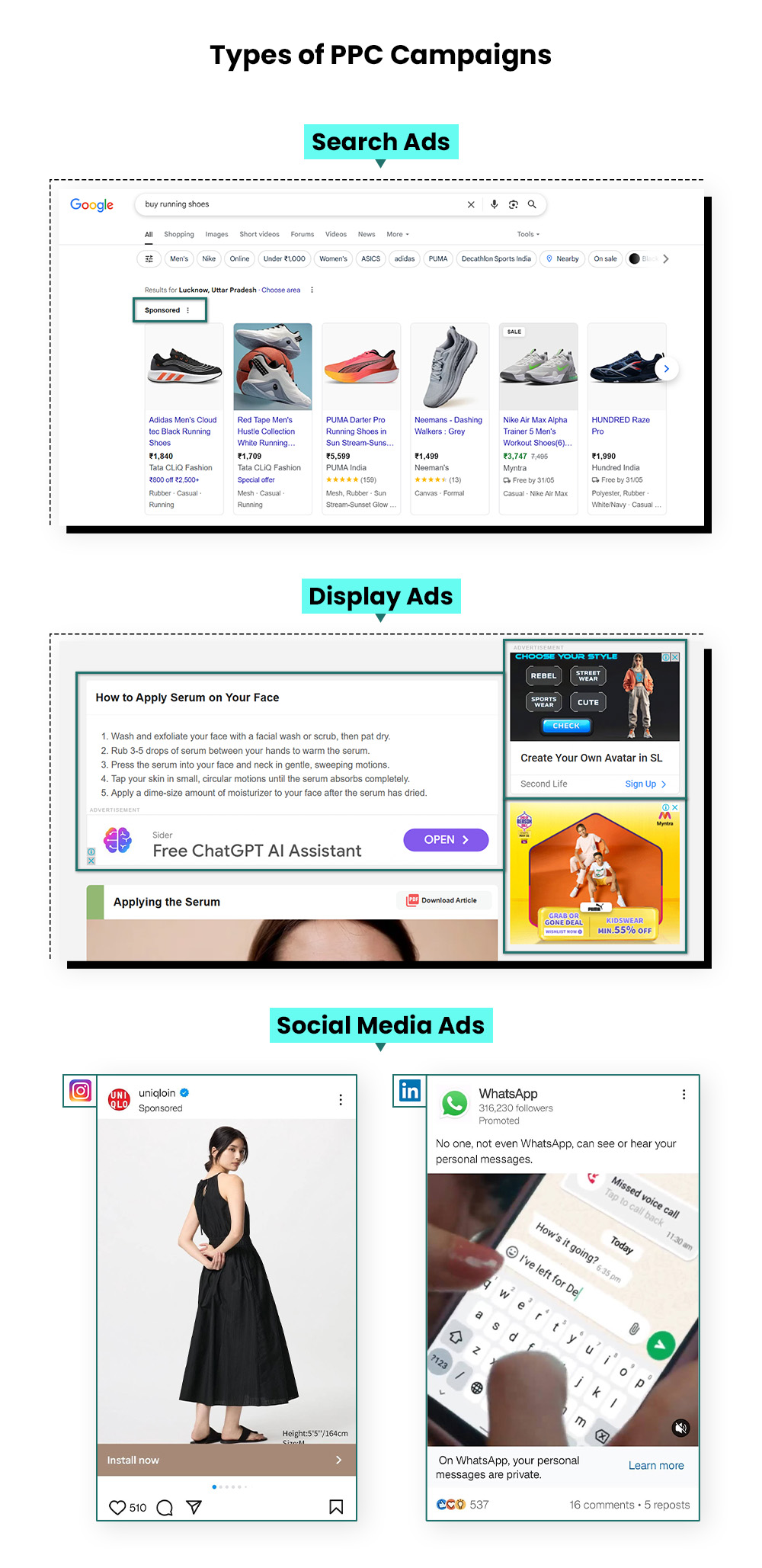
Pros of PPC
Understanding the benefits of PPC can help you decide if it’s the right choice for your marketing goals. Let’s explore them.
1. Instant Traffic
Your ad can show on Google or social media within minutes of setting up your campaign.
2. Highly Targeted
You can show ads to very specific audiences like people in a certain city, age group, or even job title.
3. Easy to Measure
You can track how many people clicked, how many bought something, and see your return on investment (ROI) clearly.
4. Flexible Budget
You don’t need a big budget to start. You can run ads for as little as $5–$10 per day.
5. Great for Testing
PPC lets you test different keywords, ads, and landing pages quickly to see what works best.
Cons of PPC
PPC has many advantages, but there are also some drawbacks you should know about.
1. Can Be Expensive
Some keywords (like “SEO vs PPC” or “digital marketing services”) are very competitive. Clicks can cost $1 to $50 or more.
2. Short-Term
As soon as your budget runs out, your ads stop, and so does your traffic.
3. Needs Ongoing Management
If you don’t know how to set up and optimize PPC properly, it’s easy to waste money on poor-performing ads.
Not sure where to start? Talk to the experts at Mastroke today.
SEO vs PPC Advertising: Which is Better for Beginners?
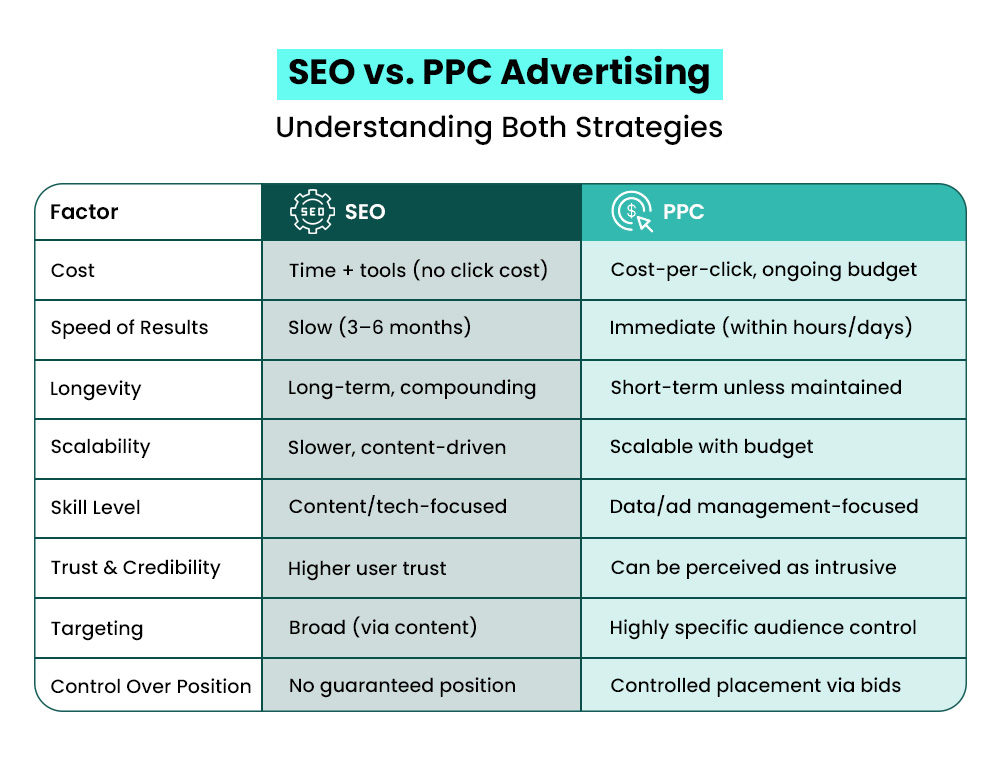
Choose SEO if:
- You have more time than money. Investing in SEO now can generate long-term, consistent organic traffic later.
- You are building a blog, brand, or authority site and want to appear in organic search results.
- You are ready to commit to content creation and improving your site structure for long-term gain.
- You are focused on building trust and credibility with users.
Example: A food blogger building their online presence should prioritize SEO to grow organic traffic from recipe-related searches.
Choose PPC if:
- You need immediate results, such as for a new product launch, a limited-time offer, or a quick test of a landing page. PPC works best for the products or services that no one or very few people know about. For example, no one was searching for “grocery home delivery” before apps like “Instacart, Amazon Fresh, or Shipt” came around.
- You have a clear budget and want measurable ROI. With the right PPC advertising management, you can quickly see what works.
- You want to test which keywords, ads, and landing pages convert before investing in long-term SEO.
Example: An eCommerce store launching a new product line can use Google PPC advertising to target ready-to-buy users.
Don’t forget to read: Save Time and Money on PPC Ads with Google Ads Editor
Use SEO and PPC Advertising Both if:
When deciding the benefits of SEO vs PPC, there are situations where using both strategies together can be highly effective. Here’s when that approach is most appropriate.
- You want immediate results and sustainable growth.
- You plan to use PPC data to identify high-converting keywords, then target those keywords with SEO.
- You are scaling your business and need traffic from both paid search and organic search.
Example: A SaaS company can use PPC ads for demos and SEO content to build trust through guides and case studies.
Pro Tip: If you’re new, start with SEO to build your site’s authority and long-term presence. Then experiment with a small PPC budget to test conversion rate, offers, or keywords. This hybrid SEO and PPC marketing strategy provides balanced growth.
Click here to read: How to Optimize Your PPC Landing Pages for SEO?
Common Mistakes Beginners Make
As a beginner, it’s easy to make a few mistakes when starting with SEO or PPC. Let’s go over the most common ones to avoid.
1. Expecting Instant SEO Results
Many beginners think SEO will bring fast results. But SEO takes time, often 3 to 6 months or more to see real progress. SEO is like planting a tree. You won’t see it grow overnight. You need to create helpful content, use the right keywords, and earn backlinks. It takes time for Google to notice and rank your pages.
2. Burning Your PPC Budget on Unoptimized Ads or Irrelevant Keywords
If you don’t set up your PPC campaigns properly, such as aligning a proper budget or picking out right keywords, you can waste your money easily.
Examples of what can go wrong:
- Bidding on broad or irrelevant keywords (e.g., targeting “marketing” instead of “digital marketing services“)
- Writing weak ad copy that doesn’t grab attention
- Sending users to a homepage instead of a focused landing page
You end up paying for clicks that don’t turn into leads or sales. That means your budget disappears quickly without results.
3. Not Tracking Conversion Rate or ROI
Some beginners only look at clicks or traffic, but don’t measure the conversion rate correctly. You might be getting lots of visitors, but if no one buys, signs up, or contacts you, your ad isn’t working. You need to track conversions (like form submissions or purchases) and ROI to know if your campaigns are profitable.
4. Thinking of It as SEO vs PPC Instead of Using Both
Many people think they have to choose one: SEO or PPC. But the best strategy often uses both together. SEO is great for long-term, low-cost traffic, but it takes time. PPC gives you instant visibility and quick testing, but it stops when the budget runs out.
Better approach: Use PPC to get quick results and test ideas, while building SEO for long-term growth. Together, they can cover the entire marketing funnel from awareness to conversion.
Get expert support for your SEO vs PPC strategy—only at Mastroke.
Practical Tips for Getting Started
For SEO:
- Use tools like Google Keyword Planner, Ubersuggest, or Ahrefs to find keywords such as “seo advertising” or “organic traffic”.
- Create helpful blog posts targeting those keywords.
- Optimize content with on-page SEO best practices (meta tags, headings, images).
- Improve site speed, mobile usability, and fix crawl issues.
- Monitor results in Google Search Console and track keyword rankings.
For PPC:
- Start with a basic campaign on Google Ads or Bing Ads.
- Choose specific, intent-driven keywords like “pay-per-click (ppc)” or “ppc advertising management”.
- Create compelling ad copy with a clear CTA (call to action) like “Get a Free Quote” or “Start Your Free Trial Today”.
- Link your ads to a relevant, high-converting landing page.
- Monitor performance and adjust targeting or budget based on ROI.
Tools & Resources
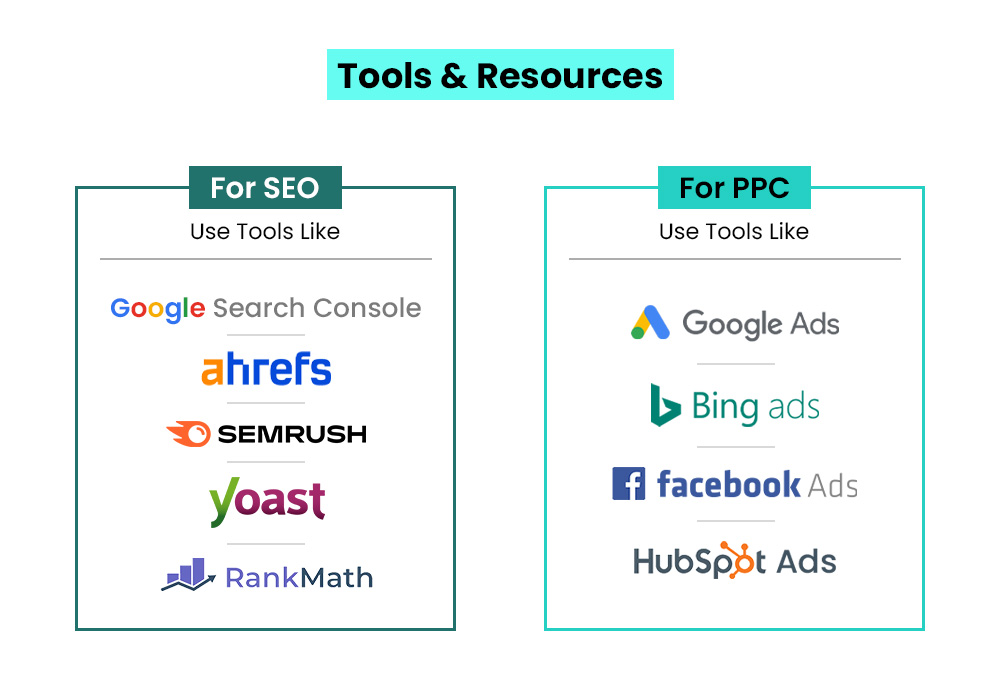
For SEO:
- Google Search Console: It tracks how your site performs in search.
- Ahrefs or SEMrush: They are powerful keyword and competitor research tools.
- Yoast SEO or RankMath: These are plugins that help you optimize WordPress content.
For PPC:
- Google Ads / Bing Ads: Run search and display ad campaigns.
- Facebook Ads Manager: Create and manage social media ads.
- HubSpot Ads Tool: Manage ads and measure ROI in one dashboard.
Also read: 17 Effective Tips to Improve Google Ads Click Through Rate
Conclusion
So, what’s better: SEO or PPC? The truth is, it really depends on your goals, how fast you want results, and how much you’re able to spend. If you’re looking for long-term growth and want to build a strong foundation that brings in free traffic over time, SEO is the way to go.
However, if you need immediate traffic, want to test different offers, or have a budget to invest in quick results, then PPC advertising might be a better choice.
But here’s the smart move: don’t think of it as SEO vs PPC. The best strategy is often to use both together. By combining SEO advertising and pay-per-click advertising, you can:
- Show up in both organic and paid results
- Cover the full customer journey from awareness to conversion
- Maximize your chances of getting more clicks, leads, and sales
At Mastoke, we specialize in helping businesses grow through both SEO and PPC. Explore our organic and paid advertising services to see how we can help you increase your visibility, attract the right audience, and get better results online.
Contact Us Today for a free consultation and discover which one will work best for your business.
FAQs
1. How much should I spend on PPC to start?
Start small, around $5–$10/day. As you collect data, increase spending on high-performing ads.
2. How long does it take to see SEO results?
Expect noticeable results within 3–6 months. Faster if you target low-competition keywords.
3. Which one is more cost-effective in the long run?
SEO is more cost-effective in the long term. Once content ranks, traffic continues without paying per click.
4. Which one needs ongoing payment, PPC advertising vs SEO?
PPC needs constant payment, but SEO mostly needs your time and effort.

Wow superb blog layout How long have you been blogging for you make blogging look easy The overall look of your site is magnificent as well as the content